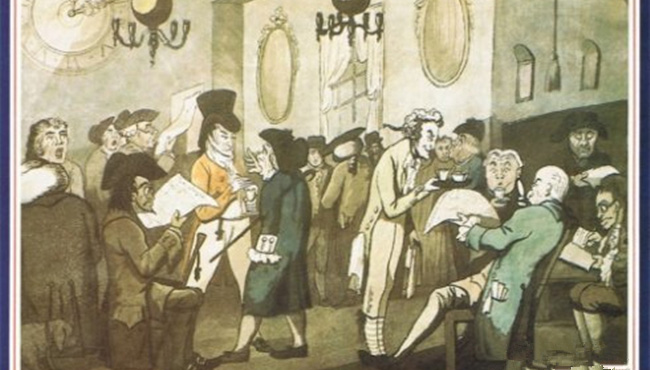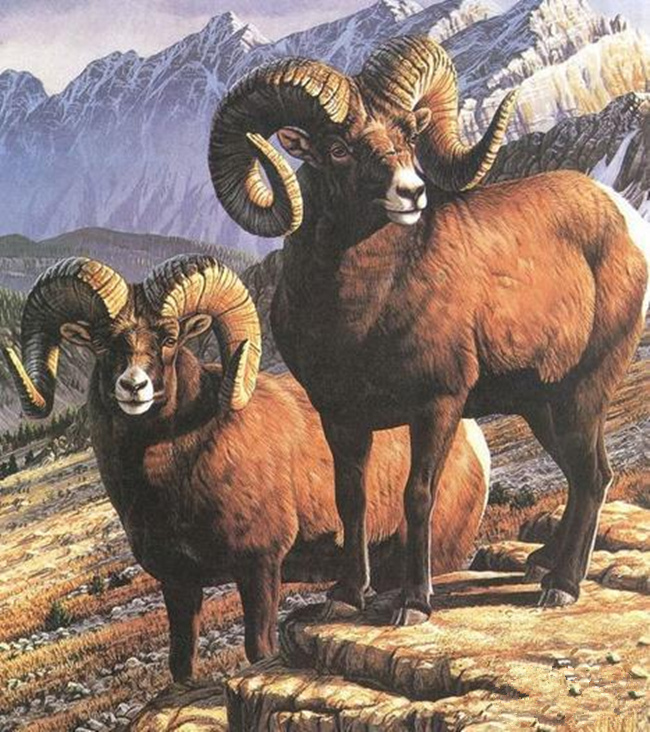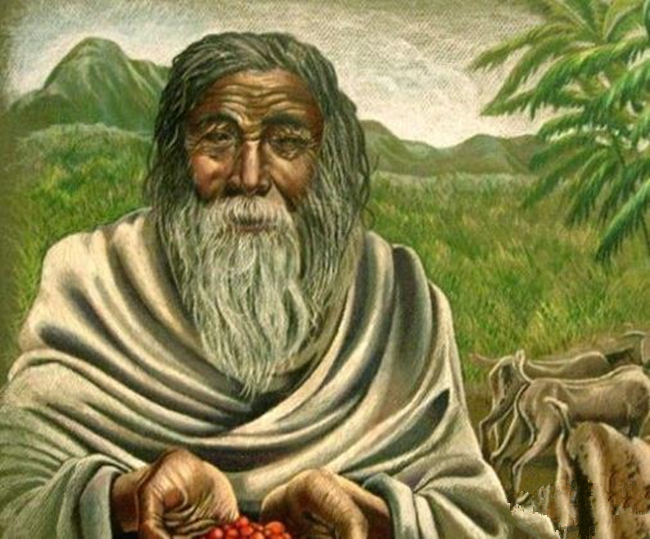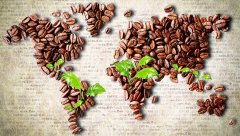The mission of coffee is to conquer the earth people?! The origin and development of coffee is so wonderful.
It is said that coffee was first discovered by goats, but the people on earth who like to taste fresh can't stop from now on. Human beings are really curious. Hey! Throughout the history of coffee, it is simply a documentary in which mankind has been conquered by it. Look at the origin and development of coffee together with [coffee culture]. As people on earth, we really don't have the strength to fight back!

Origin
Coffee was first discovered in the kaffa region of southern Ethiopia in the 6th century AD.
So far, there is no specific historical data about the origin of coffee, what has been handed down are several different legends, but it is more recognized that Cuddy, the shepherd, discovered the coffee. Legend has it that Kadi, a shepherd in Kafa province in southern Ethiopia, drives his sheep to herd every day. One day he finds that the sheep are suddenly abnormal. Normally docile and obedient, they are suddenly full of energy and alive. Cuddy wondered a little. He found that the sheep had eaten a kind of red fruit, so he picked a few of them and tasted them. He felt much less tired, more energetic, and cheered up.
Cuddy took the unknown fruit to the nearby monastery and gave it to the experienced elders. After tasting it, the elders also felt the obvious refreshing and refreshing effect of the fruit, so he ordered someone to cook soup with the fruit and share it with the monks who chanted in the evening. This unexpectedly solved the problem of monks napping at night, and this magical red fruit began to spread. Because it was first found in the kaffa area, the locals called it kaffa, and later it was called kawha in Arabic and translated as coffee in European English. At first, local people in Ethiopia used to make soup with the fruits of coffee, or mix coffee seeds with animal fat to satisfy their hunger. Ethiopia so far retains not only a large number of wild tree species, but also coffee trees in farmers' courtyards. The most primitive way of making coffee in a long-necked pot is also retained in Egypt.

Introduced into the Arab world
In 525 AD, Ethiopian troops invaded Yemen, and coffee beans were taken to Yemen by soldiers. According to records, coffee trees began to be planted in Yemen in 575 AD. Later, coffee beans were also brought to Egypt by Sudanese black slaves who were shipped to Egypt. After coffee was introduced into the Arab world, it was originally used by Arabs as a herb to treat migraines and promote digestion.
Later, the Arabs invented roasting coffee beans to make a coffee drink, which conquered the Arab taste with its unique aroma and rich flavor, and the Islamic habit of banning alcohol played a role in the spread of coffee at that time. Coffee is called "the drink given by Allah" by Arabs. It is recorded that cafes appeared in Damascus, Mecca and other places in the 15th century. After the Ottoman Turkish Empire conquered the Arab world, it developed coffee into a "national drink" and developed coffee etiquette and mysterious coffee divination. Before the 16th century, coffee was regarded as a very precious drink in the Arab world, and Arabs, especially Yemen, which grew coffee, also monopolized coffee production and strictly prohibited the outflow of coffee seeds and saplings.

Introduced into Europe
The Ottoman Turkish Empire in the 16th century was the center of East-West trade. Coffee, a mysterious drink, naturally attracted the attention of East and West businessmen, who not only formed the habit of drinking coffee themselves, but also wanted to bring this precious drink back to their country. As early as the end of the 16th century, merchants in Venice, Marseilles and London began to secretly bring a small amount of coffee beans home to receive friends with coffee at home.
In 1616, Venice merchants officially imported a bag of coffee beans to Italy for the first time. Europeans covet the seeds and saplings of coffee. In 1615, the Dutch smuggled a coffee sapling out of the port of Mocha, transported to the Netherlands and planted in a greenhouse. Coffee, a "fashionable" and "mysterious" drink from the "Eastern Ottoman Empire", was quickly accepted by Europeans, and a number of cafes came into being. In the coffee shop, people can get together to talk about current affairs, politics and various topics while drinking coffee. In addition, the coffee shop has also become a gathering place for some literati and artists. Coffee has quickly spread in Europe and penetrated into people's lives.
Introduced into North America
The earliest record of coffee in North America was probably in 1668. At the end of the 17th century, tea, cocoa and coffee were spread to North America at the same time, and tea drinking became more popular. After the famous Boston tea pouring event in 1773, coffee naturally replaced tea as the main drink.
Large-scale spread around the world
The widespread popularity of coffee in Europe has also brought some problems. A large number of imported coffee beans have caused large foreign exchange losses, coupled with the threat of freedom of speech in cafes to the rule of the authorities. At that time, the rulers of European countries first adopted a "cost-saving" approach to close cafes and ban people from drinking coffee, but coffee and cafes have become a trend, repeatedly banned, so "open source" has become a more in line with the situation. However, the climate of continental Europe is not suitable for coffee growth, so the European empires, which are in the period of colonial expansion, began to aim at their own colonies and open up coffee production areas in the tropics of Asia, Africa and Latin America.
Introduced into Asia
Coffee saplings shipped by the Dutch to the Netherlands in 1616 could not be planted on a large scale because they could not adapt to the cold climate in the north, so the Dutch transplanted them to Ceylon in 1696 and to Jakarta, Indonesia, in 1699. Indonesia became the first country in Asia to produce coffee on a large scale.
As the birthplace of Islam, Mecca, Medina and Jerusalem, as holy cities of Islam, have also attracted a large number of Eastern Muslims to make pilgrimages. These pilgrims also have the opportunity to taste coffee in Arabia and repeatedly try to take it out of the Arab world. As early as the 17th century, during a pilgrimage to Mecca, Babudan, an Indian Muslim, secretly took seven coffee beans out of Yemen and transported them to southern India, where coffee was introduced into India.
Introduced into Central and South America
In the 1820s, French naval officer de Klee transported a coffee sapling to Martinique Island in Central America, and Martinique coffee saplings were spread to Haiti, Dominica and other Central American island countries.
At the same time, coffee seedlings were spread to Cuba and Jamaica in Britain.
Coffee is grown on a large scale in French Guiana, Suriname, Haiti and other countries.
Spain grows coffee in its own territories such as Colombia and Peru.
Coffee seedlings spread from French Guiana to Brazil, where the coffee industry sprang up and became the largest producer in the world at the beginning of the 20th century.

Introduced into Africa
At the end of the 19th century, coffee was widely grown in British colonies in Africa. In 1893, the coffee industry of Kenya, the neighbor of Ethiopia, began to develop and rapidly developed into a high-quality coffee producer.
Introduced into Hawaii
Coffee spread to the Hawaiian islands in 1825.
Introduced into Australia
Coffee was first introduced to Australia in the 1880s.
Coffee spread to the Hawaiian islands in 1925.
So far, with Brazil as the leader, with the Tropic of Cancer as the boundary, coffee planting territory has been formed across the east and west of the earth, stretching across the four continents of Asia, Africa, the United States and Australia.
The spread of coffee in China
In 1884, the British first spread coffee to Taiwan, and Taiwan began to grow coffee. In the era of Japanese occupation, coffee became popular in Taiwan.
In 1892, French missionaries brought coffee from Vietnam to Binchuan County, Yunnan Province, which was the earliest record of coffee cultivation in Chinese mainland. At present, coffee cultivation in China is mainly concentrated in Yunnan and some areas of Hainan.
The history of coffee drinking in China can be traced back to the late Qing Dynasty. With the opening of the country, coffee began to appear in the eastern coastal cities. There are records of coffee in the poems of the late Qing Dynasty, such as the bamboo branch word "Kao Fei", which was popular in Shanghai at that time. Colored sugar is sweet and bitter, and westerners cook tea for each meal. In the 1920s and 1930s, some cafes have appeared in old Shanghai and Kunming. Coffee shops and cafes temporarily disappeared at the beginning of the founding of New China. After the reform and opening up, coffee has made a comeback.
Since the 1980s, Nestl é and other brands have landed in China, "instant coffee" has become synonymous with coffee, and with the expansion of some domestic and foreign chain cafes in the 21st century, various star hotels have launched coffee as an important drink, which has promoted the development of the domestic coffee industry, but as a traditional tea drinking country, the quality of domestic coffee is still mixed, and the local coffee culture has not been formed. All these need to be further developed.
Important Notice :
前街咖啡 FrontStreet Coffee has moved to new addredd:
FrontStreet Coffee Address: 315,Donghua East Road,GuangZhou
Tel:020 38364473
- Prev

Coffee origin and flavor characteristics Coffee tasting terms
Coffee category freshly ground coffee: generally canned large bottles, beans look different sizes, there are oval Arabica (Arabica), there are round Robusta. Baking color uniformity varies greatly, not full, coffee beans can see the traces of dry crack, not shiny! It smells like a faint coffee aroma. If it is ground on site, it will generally have an instant aroma.
- Next

The difference between White Coffee and Black Coffee Coffee basic knowledge
Many people will think, as the name implies, that the two are one color is black and the other is white, wrong! The biggest essential difference between white coffee and black coffee is in its processing process! Now most of the coffee on the market is black coffee. White coffee is a native product of Malaysia with a history of more than 100 years. Many people will think that white coffee is a white powder. It's just me.
Related
- Beginners will see the "Coffee pull flower" guide!
- What is the difference between ice blog purified milk and ordinary milk coffee?
- Why is the Philippines the largest producer of crops in Liberia?
- For coffee extraction, should the fine powder be retained?
- How does extracted espresso fill pressed powder? How much strength does it take to press the powder?
- How to make jasmine cold extract coffee? Is the jasmine + latte good?
- Will this little toy really make the coffee taste better? How does Lily Drip affect coffee extraction?
- Will the action of slapping the filter cup also affect coffee extraction?
- What's the difference between powder-to-water ratio and powder-to-liquid ratio?
- What is the Ethiopian local species? What does it have to do with Heirloom native species?

